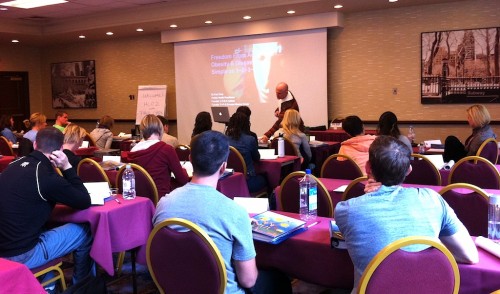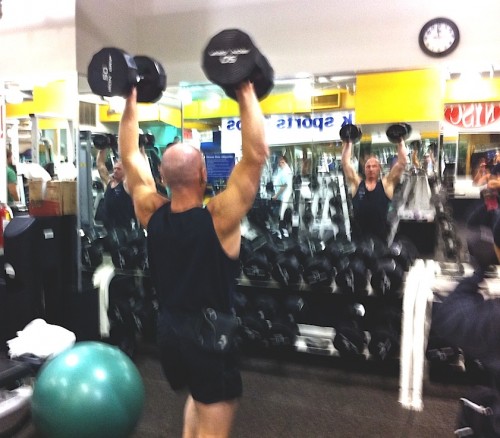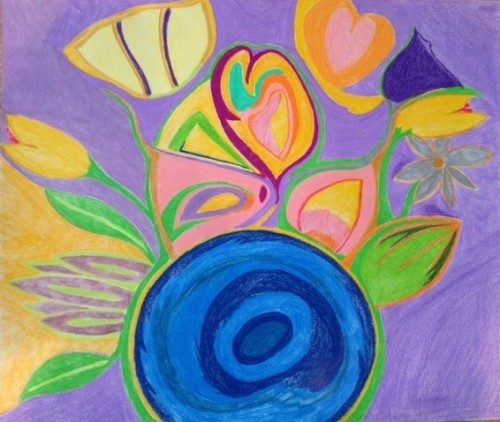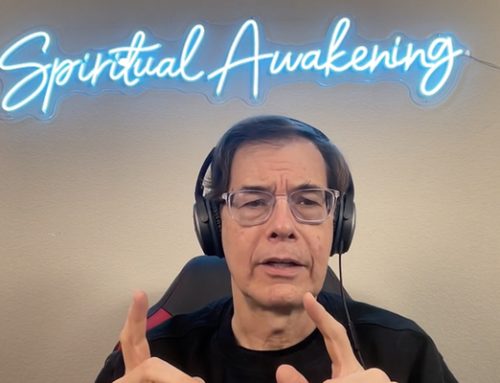Good Wednesday to You!
My day began a little before 6:00 AM yesterday. I needed to take a cold shower to wake myself up before I wrote my blog, reviewed my slides for the day, and ate breakfast.
I headed down to set myself up for presenting at about 8:15 and found a group of lively looking students from around the world.
It’s been wonderful for me to see how much healthier, calmer, and more focused my students have been since creating my Holistic Lifestyle Coaching, Level 1 (HLC 1) program.
The students have usually been applying the principles in my book, How To Eat, Move and Be Healthy! for some months by the time I meet them in HLC 2.
It didn’t use to be that way. . .
When I first started the HLC training program, there was only a level 1 and level 2 program. The fist level was what I use to teach as HLC 2, and the second level is what is now HLC 3.
When I saw how many very unfit and unhealthy people were taking a course designed to teach professionals how to approach nutrition and lifestyle coaching holistically, I became very concerned.
I made the decision to put a new HLC 1 program together, with the emphasis on putting the principles in practice for six months before attending HLC 2 and trying to learn how to coach others.
I found from experience that when a person is insecure about their authenticity, there is a tendency to counterbalance with intellectual over reliance.
They can tell you all about the current health products, devices and methods being used, but have rarely ever tested any methods or systems on themselves.
Therefore, most everything they teach their clients has only a theoretical basis and has to be referenced to someone else.
The students coming into the program now typically have the confidence that they know how to meet their individual nutritional needs.
They have a good enough general knowledge of, and experience with exercise that they can easily be taught to design functional programs.
They have usually noticed a significant change in their energy levels and often experience positive body shape transformations.
Because these experiences are a lived reality for them, there is less fear of academic assault; they know there are opinions on every side of every argument by equally qualified “experts”, and that all that matters at the end of the day is if a given approach actually gets results, and for who.
I feel it is essential to have the skill set necessary to individualize a holistic nutrition and lifestyle-coaching program.
We are as different on the inside as we are on the outside!
Once you’ve learned how you best respond to various methods, you’ve also learned from experience what questions to ask another about themselves, or their experiences.
This makes learning both practical, and more efficient.
As I met the students via their introductions yesterday morning, I was surprised at how many there were from a wide variety of locations around the world.
It was fun to learn what each of them had studied thus far, and what their dream was for the course.
I felt their spirits to be strong!they have to be to put up with me as a their teacher ☺.

We put in a long day yesterday. Class started at 8:30 AM and we didn’t finish until about 7:00 PM.
I taught the students a fair bit about the importance of optimal breathing, breathing physiology, and the mechanics of breathing. I showed them simple, effective methods of analyzing a person’s breathing pattern and how to correct imbalances.
We discussed the effects of diet on breathing, and I explained why it is that you can almost never restore people to an optimal breathing rate if they continue to eat sugar.
We got time to practice with each other too, and there was plenty for them to see and work with.
After some time in Bryant park with a tai-chi exercise I learned by following my body’s inner-wisdom, we had practiced restoring our biological oscillators and biological pumps to harmony.
Many of the students had the eye of calm after that experience. Some were feeling their own inner-guidance coming forth to greet them as they relaxed into the experience.

Looking outside the classroom window, you can see that NY has streets of black, white and yellow. As many cabs as there are, during high traffic hours, you can definitely get stuck on the side of the road for a while.
After lunch, we worked pretty comprehensively through my 1-2-3-4 formula for designing health and wellness programs. The students were very present with me throughout the day and to keep them from falling too far from the action, I told them a cheezy joke or two now and then.
It was pretty late for me by the time I got into the gym. I put in a decent half hour or so of push-presses, Swiss ball dumbbell bench presses, some SB push-jacks, and some high-cable rows.
Then I headed in for a good sweat in the steam bath.
The day flew by like an arrow and I’m sure today will do the same!
Below, I’ve added a great piece of art and a lovely short story by Kris Timpert, a CHEK Level 4 and PPS Success Mastery Practitioner. Kris has served as a PPS Success Mastery Mentor and she has some love to share with you today!
Enjoy,
Love and chi,
Paul Chek
Cultivating your Garden of Happiness
By Kristine Timpert
What is the secret formula for being happy? It seems most of us, no matter how hard we try are always coming up short.
For me, I believe happiness is learning how to be a good Gardener. We are taught many things as small children but no one ever tells you how to create a life where you are truly happy.
So let’s look at a typical garden. If we want to grow green beans and tomatoes, we drive to the store to purchase green bean and tomato seeds. We prepare a patch of fertilized soil, place a fence around it to keep the critters out and plant our seeds into the ground.
After enough water and sunshine, behold; green beans and tomatoes rise up out of the ground – amazing! Now of course we’ll have weeds to deal with; that’s just part of having a garden. So everyday we spend a few minutes pulling them out in order to reserve the rich soil for the crop we are trying to grow.
When it comes to being happy, the same method can easily be applied into your life. Since the most important ingredient is the seed we push deep into the soil, we need to get some happiness seeds. These seeds are abundant and come from every kind thought, word and action we offer to (ourselves and) other people in our life.
Let’s say we want a loving relationship. To plant companionship into your life, you become a companion to someone else. Maybe you visit someone who is sick or help an elderly neighbor by bringing them the newspaper. Any act of kindness to another has no alternative but to grow kindness into your life.
However, if you tend your garden being angry with others or blaming them for the weeds, your garden will have no choice but to produce people who are angry and blame you. It’s all about what you want to see grow in your life.
The universe is wired this way. How we treat others is what our garden grows. Let’s say you want more money in your life. To plant the seeds of abundance, you have to be generous with your love.
You can start by giving someone a phone call you haven’t talked to in a while or buying a stranger a cup of coffee. It doesn’t have to be a lot of money just a focused intention behind the giving to plant a seed for yourself. The garden will grow according to the method you use to tend it.
This may sound as though it makes no sense but I promise if you try it, you will start to see the seeds blossom. The more loving you are to people who don’t behave in a way that’s loving, the more love will come into your life.
Life is just a big beautiful garden of cause and effect; it’s beautiful really. If you can grow your understanding that every negative experience was simply a result of a bad seed you planted in your past, then you can just watch it unfold with awareness instead of reacting and planting that very seed into your garden again.
Now, of course, there will be weeds that pop up. The best way to weed your garden is to spend a few minutes at the end of each day thinking about what you did that was good and what you thought, said or did that wasn’t. Start with how you spoke to and acted toward yourself.
We typically won’t authentically love another any more than we will love ourselves. Once we experience the joy and freedom of loving ourselves, we naturally want to share those seeds with others. When others experience our love garden, they are most likely to want to contribute to our too! This simple technique will clean up the soil of your life while encouraging even more wonderful things to grow in relationships all around you.
So to really be a good Gardener, you invite yourself to be kind to others; not just for them, but for you. You start to make the world a better place by holding a door open for someone or throwing out a bottle you find on the ground. Anything you do to help someone else will plant a powerful seed into your garden of happiness.
Just imagine if everyone behaved this way. Each person helping another because they knew it would come back to them; not from the person they helped but from somewhere else. If instead of being better than the competition, we actually helped promote their business, that would blossom into other people promoting ours.
When we keep kindness and success to ourselves, we block the potential for even more kindness and success from everyone else on the planet. When we share it, we are like birds spreading the seeds of love across many gardens.
I don’t believe there is a limit to abundance. If we can stay focused on tending our own garden, we can rest assured we are teaching others how to tend there’s. It’s human to emulate those that grow what we want in our garden, and to avoid those that are passing out weeds. Just imagine what it would be like if everyone knew how to be a good gardener!
Kris Timpert is a CHEK Level 4 Practitioner and a PPS Success Mastery mentor. If you would like to learn more about Kris or contact her, you can reach her at: https://www.kristimpert.com/






